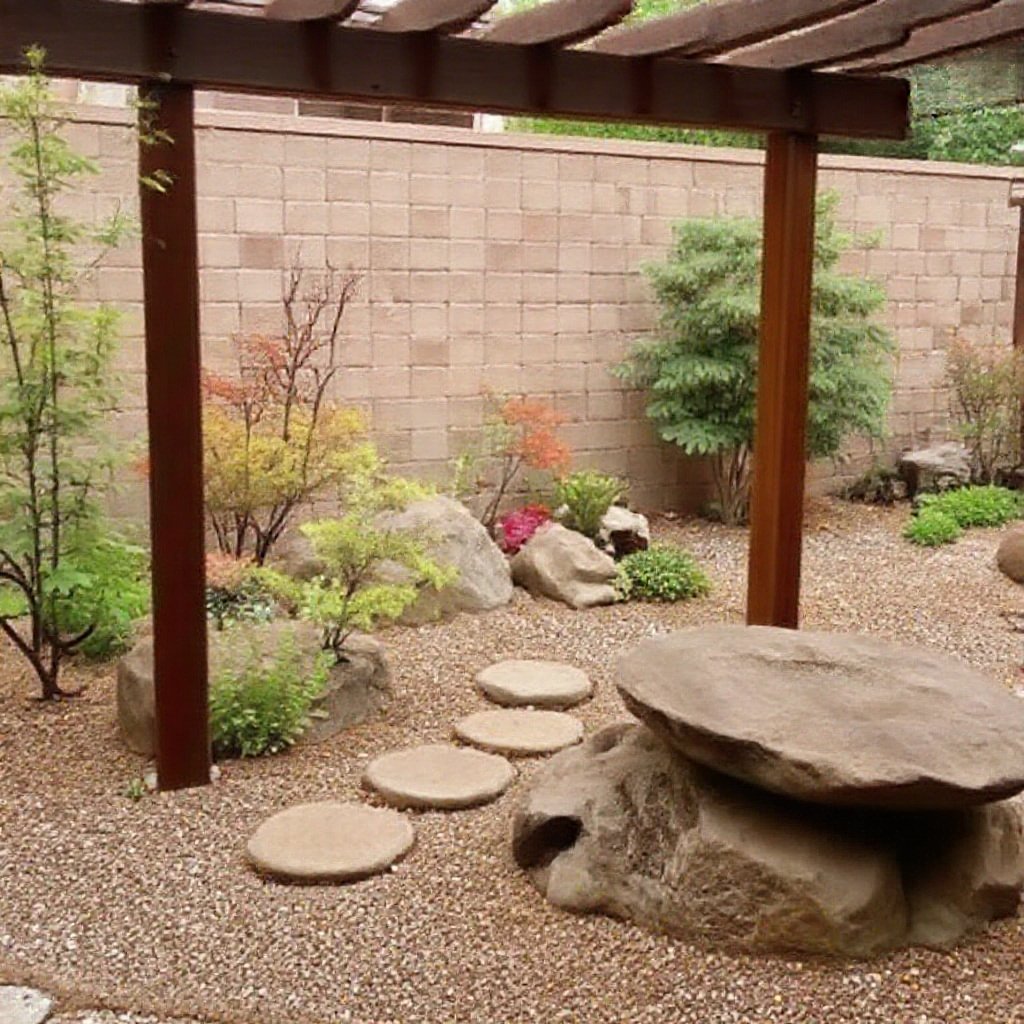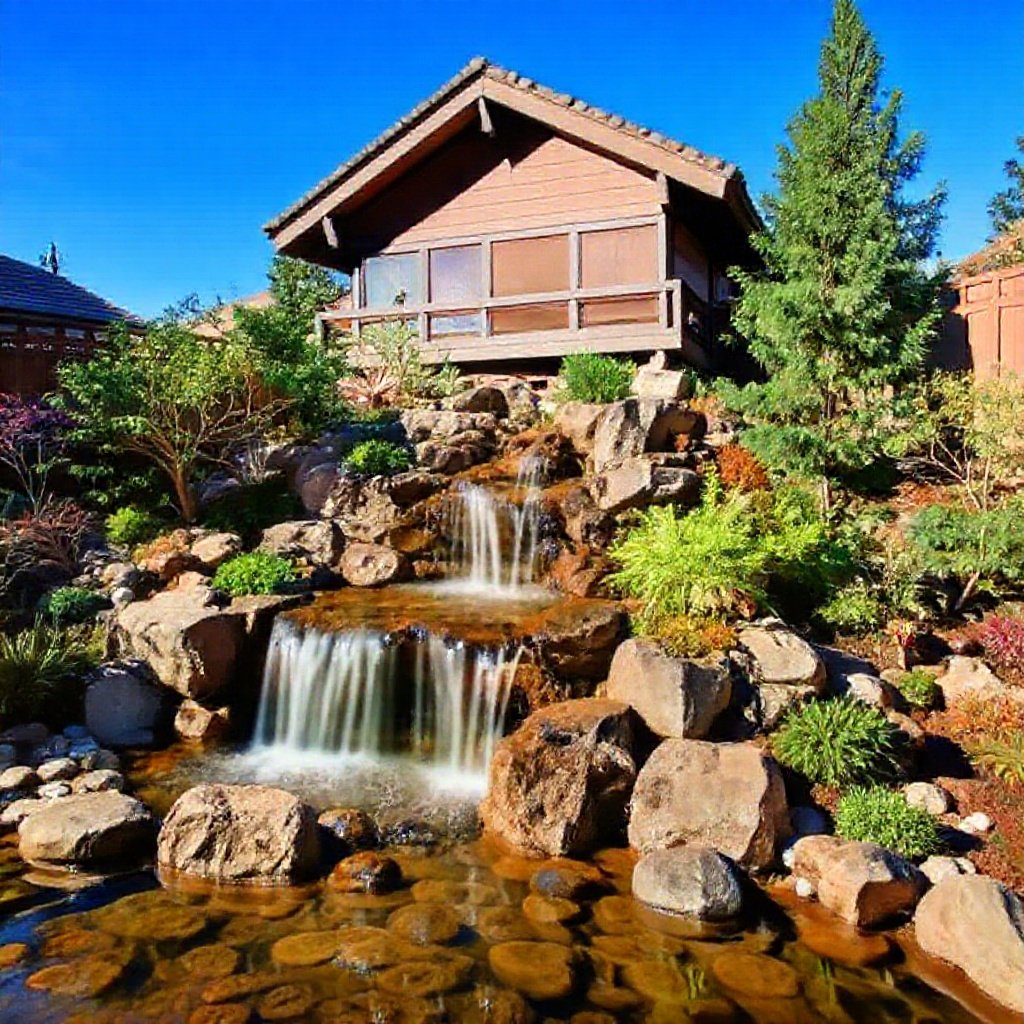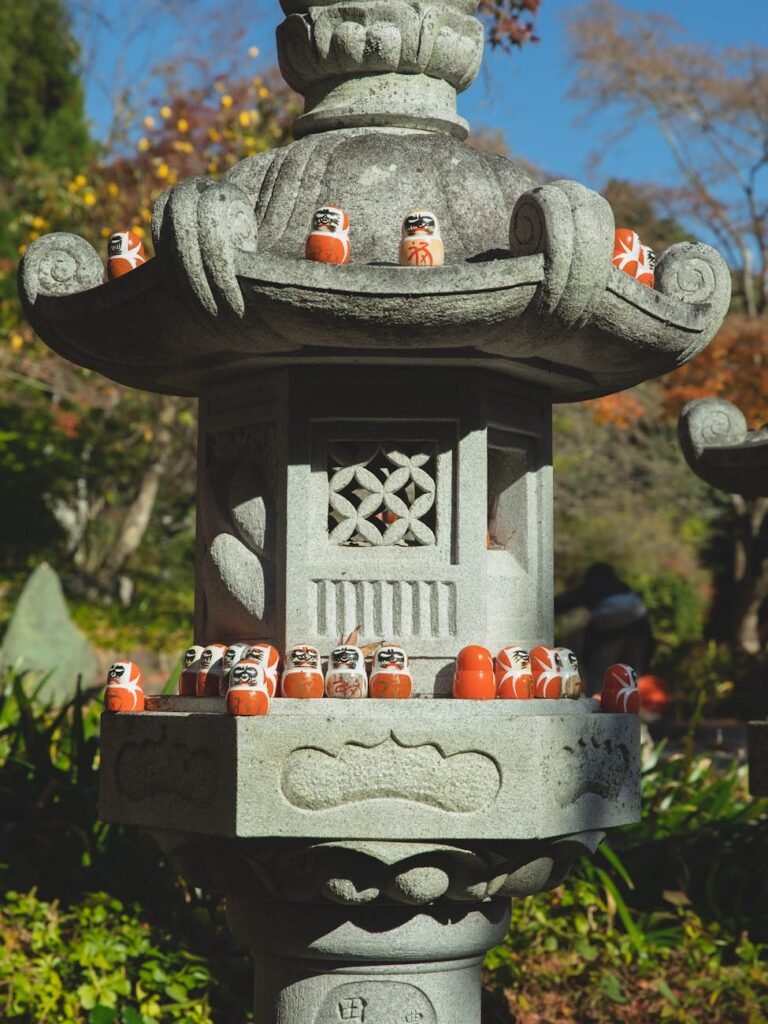Introduction to Zen Gardens
What Are Zen Gardens?
Zen gardens, born from Zen Buddhism, are all about capturing nature’s vibe and creating a chill spot for meditation. Also called Japanese rock gardens, they feature a mix of rocks, moss, pruned trees, and raked gravel or sand. The goal? To spark tranquility, simplicity, and harmony with nature.
| Element | Description |
|---|---|
| Rocks | Stand in for mountains or islands, placed just right for balance |
| Moss | Shows nature’s persistence, adding a splash of green |
| Pruned Trees | Trimmed to perfection, symbolizing longevity |
| Raked Gravel/Sand | Mimics water, with patterns that look like waves or ripples |
These gardens are a big deal in Japanese culture, embodying Zen philosophy by promoting mindfulness and a deep bond with nature.
Benefits of Zen Gardens
Hanging out in a Zen garden can seriously chill you out, boost relaxation, and improve your overall vibe. The minimalist setup helps clear your mind, sharpen focus, and encourage mindfulness. It’s like having a peaceful retreat right in your backyard, perfect for reflection and finding inner peace.
Benefits of Zen Gardens:
- Stress Buster: The calm environment helps knock down stress levels.
- Mindfulness: The simple design nudges you into a mindful state.
- Focus Booster: The garden’s layout helps you concentrate better.
- Inner Peace: Offers a spot for deep thought and reflection.
For more tips on bringing Zen vibes into your garden, check out our section on zen garden landscaping and dive into various japanese garden design ideas.
Elements of a Japanese Garden
Traditional Japanese Garden Features
Creating a small Japanese garden? Let’s dive into the essentials. These features bring peace, simplicity, and harmony, reflecting the heart of Japanese culture.
Stone Lanterns (Ishi-dōrō): These lanterns add a touch of history and softly light up pathways. They often symbolize enlightenment (Japanese Garden Lanterns).
Water Features: Water is a must-have, symbolizing purity and life. Think ponds, streams, and waterfalls (Japanese Garden Water Features).
Bridges (Hashi): Bridges represent life’s journey, usually arching over water, creating a peaceful crossing (Zen Garden Landscaping).
Plants: Traditional plants like bamboo, maple trees, and cherry blossoms bring seasonal beauty and structure. They’re chosen for their looks and meanings.
Rocks and Gravel: Rocks stand for mountains and islands, while gravel or sand symbolizes water. These are arranged to create balance and natural beauty.
Incorporating Zen Principles
Zen principles are key in Japanese garden design. They focus on mindfulness, simplicity, and the natural flow of elements.
Simplicity (Kanso): It’s about cutting out the unnecessary and focusing on what matters. This means minimalism in design, making sure every element has a purpose (Japanese Garden Design Ideas).
Asymmetry (Fukinsei): Unlike Western gardens that love symmetry, Japanese gardens embrace the imperfect beauty of nature. This makes the garden feel natural and unforced.
Naturalness (Shizen): This means letting the garden blend with its surroundings. Use native plants and natural materials to create harmony.
Tranquility (Seijaku): Achieve peace through careful arrangement of elements. Water features and shaded seating areas help create a serene vibe.
Subtlety (Yūgen): This is about understated beauty that invites thought. Use muted colors, delicate plants, and gentle textures.
By blending these traditional features and Zen principles, you can turn your small garden into a peaceful retreat. Each element should be thoughtfully placed to create a harmonious and tranquil space that captures the essence of a Japanese garden.
For more tips, check out our Japanese Garden Design Ideas and Zen Garden Landscaping pages.
Designing a Small Japanese Garden
Creating a small Japanese garden is like crafting a peaceful retreat right in your backyard. It’s all about thoughtful planning and a keen eye for detail. Here’s how you can make your own little slice of Zen.
Making the Most of Your Space
When you’re working with a small area, every inch counts. The trick is to make the space feel bigger than it is. Here’s how:
| Space Trick | What It Does |
|---|---|
| Illusion of Depth | Use different heights and perspectives to make the garden feel more spacious. |
| Multi-functional Elements | Choose items that do double duty, like a rock that can also be a seat. |
| Vertical Space | Think upwards with climbing plants or hanging features. |

Need more ideas? Check out our Japanese garden design ideas.
Picking the Right Plants
The plants you choose can make or break your garden. You want ones that fit the space and add to the peaceful vibe.
| Plant Type | Why It’s Great | Example |
|---|---|---|
| Moss | Soft ground cover that’s easy on the eyes | Sphagnum |
| Bamboo | Grows up, not out, and adds a soothing sound | Dwarf Bamboo |
| Flowering Shrubs | Adds seasonal color and lovely scents | Azalea |
For more plant inspiration, take a look at our Zen garden landscaping.
Arranging Rocks
Rocks aren’t just rocks in a Japanese garden—they’re symbols of mountains, islands, and more. Here’s how to place them:
| Rock Arrangement | What It Means |
|---|---|
| Single Large Rock | Represents a mountain or island |
| Group of Three Rocks | Symbolizes Heaven, Earth, and Humanity |
| Gravel Patterns | Mimics flowing water or ripples |
Want to add water features? Visit our page on Japanese garden water features.
By paying attention to space, plant choices, and rock placements, you can create a small Japanese garden that’s a perfect spot for relaxation and mindfulness.
Creating a Chill Japanese Garden
Got a small space but big dreams of a peaceful Japanese garden? Let’s make it happen! Here’s how to bring in water features, bamboo, and pathways to turn your garden into a serene escape.
Water Features
Nothing says “relax” like the sound of water. Whether it’s a fountain, pond, or waterfall, these features can drown out the noise of the outside world and bring a sense of calm.
| Water Feature | Why It’s Awesome |
|---|---|
| Fountain | Constant, soothing sound that masks city noise |
| Pond | Visual calmness and a home for koi fish |
| Waterfall | Eye-catching and enhances the sensory experience |

Need more ideas? Check out our Japanese garden water features.
Bamboo Magic
Bamboo isn’t just for pandas. It’s a versatile plant that can create privacy screens or add a calming vibe to your garden. Plus, it’s all about that Zen simplicity.
- Privacy Screens: Tall bamboo acts as a natural barrier, giving you a private, serene space.
- Accents: Use bamboo poles in garden decor or as plant supports.
- Bamboo Fences: Traditional Japanese bamboo fences can define spaces and add authenticity.
For more bamboo inspiration, visit our Japanese garden design ideas.
Pathways and Bridges
Pathways and bridges aren’t just for getting from point A to point B. They guide you through your garden, creating a journey of peace and balance.
| Pathway/Bridge Type | Why You’ll Love It |
|---|---|
| Stone Pathway | Adds a natural, grounding element |
| Wooden Bridge | Creates a focal point and can span a pond or dry stream |
| Gravel Path | Easy to maintain and enhances the Zen look |
Need more tips? Dive into our articles on Zen garden landscaping and Japanese garden lanterns.
By adding these elements, you can turn your small Japanese garden into a tranquil retreat that’s all about harmony and peace.
Keeping Your Zen Garden Zen
Taking care of your Zen garden isn’t just about keeping it tidy—it’s about preserving that peaceful vibe. Here’s how to keep your garden looking and feeling serene.
Pruning and Trimming
Snip, snip! Regular pruning and trimming keep your garden looking sharp and harmonious. I always grab my trusty shears to trim back overgrown branches and shape shrubs. This not only keeps things neat but also helps plants grow better.
Pruning Tips:
- Chop off dead or sick branches ASAP.
- Shape shrubs and trees in classic Japanese styles.
- Prune flowering plants after they bloom to encourage new growth.
Need more pruning tips? Check out Pruning and Trimming Techniques for a Healthy Garden.
Weed Control
Weeds are the enemy of tranquility. They mess up the look and steal nutrients from your plants. I stick to organic methods to keep my garden chemical-free and zen.
Weed Control Hacks:
- Yank out weeds by hand regularly.
- Use mulch to keep weeds at bay.
- Lay down landscape fabric under gravel or rocks for extra protection.
For more on organic weed control, visit Organic Weed Control: Tips for a Chemical-Free Garden.
Seasonal Care
Your Zen garden needs different TLC depending on the season. Each season brings its own chores to keep your garden looking its best.
Seasonal Chores:
| Season | To-Do List |
|---|---|
| Spring | Clear winter debris, fertilize, and check for pests. |
| Summer | Water often, prune dead blooms, and fight weeds. |
| Fall | Rake leaves, trim perennials, and prep for winter. |
| Winter | Protect delicate plants, cover water features, and limit foot traffic. |
For a full guide, visit Seasonal Garden Maintenance Guide.
Keeping your Zen garden in top shape takes some effort, but the peace it brings is totally worth it. Want more Zen garden tips? Check out our sections on Zen garden landscaping and Japanese garden design ideas.
Personalizing Your Zen Garden
Creating a Zen garden that mirrors your tastes can boost its calming vibes and make it a true retreat. Let’s dive into some ways to add personal touches and bring meditative practices into your little Japanese haven.
Adding Personal Touches
Garden Ornaments
Toss in some traditional Japanese elements like lanterns, statues, or tiny pagodas. These can sprinkle a bit of authenticity and peace into your garden. Need ideas? Check out our guide on Japanese garden lanterns.Unique Plant Choices
While classic Japanese gardens have their go-to plants, you can jazz up your space with your favorite flora. Think about adding seasonal blooms or local plants that thrive where you live. For more plant ideas, visit our section on Japanese garden design ideas.Custom Rock Arrangements
Rocks are a big deal in Zen gardens, symbolizing mountains or islands. Arrange them in a way that clicks with you. Maybe create a dry riverbed or a rock formation that means something special. Learn more about rock arrangements in our article on Zen garden landscaping.Water Features
A small water feature like a fountain or koi pond can up the tranquility factor. The sound of flowing water is naturally soothing. For inspiration, explore our section on Japanese garden water features.Pathways and Bridges
Design pathways and bridges that invite mindful walking and contemplation. Use natural materials like bamboo or stone to create a harmonious flow. Visit our article on Japanese garden pathways for more ideas.
Meditative Practices in the Garden
Mindful Walking
Create a walking path for slow, deliberate steps. This practice, known as Kinhin in Zen Buddhism, can help center your mind and body.Zen Sand Raking
Raking patterns into the sand or gravel is a meditative activity that symbolizes the flow of water. It’s a simple yet effective way to focus your mind and find inner peace.Breathing Exercises
Use your garden as a backdrop for breathing exercises or meditation. The natural surroundings can enhance your practice and help you achieve a deeper state of relaxation.Yoga and Tai Chi
Your Zen garden can also serve as a serene space for yoga or Tai Chi. These practices promote physical and mental well-being, aligning perfectly with the principles of Zen.Journaling
Spend time in your garden writing about your thoughts and experiences. The act of journaling in such a peaceful setting can be incredibly therapeutic and insightful.
By adding these personal touches and meditative practices, you can turn your small Japanese garden into a unique and tranquil haven. For more ideas on creating a Zen garden that suits your lifestyle, explore our comprehensive guide on Japanese garden design ideas.
For more peaceful gardening ideas, please check out How Peaceful Gardening Can Transform Your Mental Health!

My name is Michelle Warren, and I’m the founder of Peaceful Gardening. As a 10-year breast cancer survivor, I’ve discovered the profound therapeutic power of gardening. This journey has not only helped me recover but has also become my passion and a source of ongoing peace and joy.
Peaceful Gardening was born from my desire to share the healing benefits of gardening with others. Whether you’re facing health challenges, dealing with stress, or simply looking to connect more deeply with nature, this space is for you.
Over the past decade, I’ve cultivated not just plants, but a deep understanding of how gardening can positively impact mental health. I’ve worked with local community gardens, led workshops on mindful gardening practices, and collaborated with mental health professionals to develop gardening-based stress reduction programs.
Peaceful Gardening was born from my desire to share the healing benefits of gardening with others. Whether you’re facing health challenges, dealing with stress, or simply looking to connect more deeply with nature, this space is for you.
Here, you’ll find evidence-based advice on using gardening as a tool for mindfulness, stress relief, and emotional healing. I share personal stories, practical tips, and scientifically-backed information on how to create your own therapeutic garden space, no matter the size of your yard or balcony.
My mission is to help you discover the joy, peace, and healing that comes from nurturing plants and connecting with nature. Join me in exploring how the simple act of tending to a garden can transform your mental and emotional wellbeing.
Welcome to Peaceful Gardening – let’s grow together towards better mental health!”

